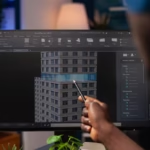In the ever-evolving world of architecture, the role of technology has become paramount in shaping the future of design, construction, and sustainability. As we look to the future, technological innovations are influencing every facet of architecture, from the tools used by architects to the materials and methods of construction. The integration of cutting-edge technology offers opportunities to create smarter, more efficient, and more sustainable buildings.
1. Design and Visualization Tools
One of the most significant ways technology is shaping architecture is through advanced design and visualization tools. Software like Building Information Modeling (BIM) allows architects to create detailed 3D models of buildings that can simulate various environmental factors such as lighting, airflow, and energy consumption. BIM not only makes the design process more efficient but also enables better collaboration among various teams, from architects to engineers, contractors, and even clients.
Virtual Reality (VR) and Augmented Reality (AR) have also transformed the way architects visualize their designs. Through VR, architects can give clients immersive walkthroughs of buildings before construction even begins, making it easier to identify potential design flaws or make adjustments. AR enhances the physical world by overlaying digital elements, enabling architects to better plan spaces in real time.
2. Smart Materials and Construction Techniques
As sustainability becomes a greater concern, the role of technology in developing smart materials and construction techniques is crucial. Advances in material science have led to the creation of smart materials that can adapt to environmental changes. For example, self-healing concrete can repair cracks over time, reducing the need for costly repairs and maintenance. Similarly, transparent solar panels can function as windows while simultaneously generating energy, making buildings more energy-efficient and environmentally friendly.
Additionally, technologies like 3D printing are revolutionizing construction. This innovation allows for the rapid production of building components, reducing material waste and labor costs. 3D-printed buildings can also be constructed faster, making them ideal for addressing housing shortages in rapidly growing urban areas.
3. Sustainable Architecture
The focus on sustainability in architecture has grown immensely over the last few decades, and technology plays a key role in this shift. Smart building systems, powered by the Internet of Things (IoT), are helping to create energy-efficient buildings that respond to changes in temperature, lighting, and occupancy. Sensors embedded in walls, windows, and HVAC systems can monitor energy usage in real-time and adjust the environment accordingly. For example, lights may dim when natural light floods a room, or temperature settings can adjust automatically based on the number of people in a space.
Furthermore, renewable energy technologies such as solar panels, wind turbines, and geothermal systems are increasingly incorporated into building designs, reducing reliance on nonrenewable energy sources and minimizing a building’s carbon footprint. Technology also aids in waste management and water conservation, with systems in place that capture and reuse rainwater, monitor waste generation, and even create systems for composting organic waste.
4. Automation and Artificial Intelligence (AI)
The integration of automation and AI into architectural practices is revolutionizing how buildings function and interact with their occupants. Intelligent buildings powered by AI can predict and respond to the needs of inhabitants, adjusting temperature, lighting, and security based on individual preferences. Automation systems can manage energy consumption more effectively, contributing to cost savings and greater environmental responsibility.
AI is also being used in the design phase to optimize layouts and workflows. AI algorithms can analyze vast amounts of data to determine the most efficient use of space, predict potential issues during construction, and help architects create designs that are not only aesthetically pleasing but also functional.
FAQs on Technology’s Role in Future Architecture
1. How does technology impact the sustainability of modern architecture?
Technology improves sustainability by allowing the creation of energy-efficient buildings with renewable energy integration, better waste management, and smarter resource use. Smart sensors, energy-efficient materials, and automation contribute to a reduced carbon footprint.
2. What is BIM, and how does it benefit architects?
Building Information Modeling (BIM) is a digital tool that allows architects and other stakeholders to create detailed 3D models of buildings. It benefits architects by enabling precise design, better collaboration, and real-time updates, reducing errors and improving the overall quality of construction.
3. Can AI help in designing buildings?
Yes, AI can help architects by analyzing data and offering design suggestions, predicting potential issues, and optimizing spaces. It can also simulate different building performance outcomes, making the design process more efficient.
4. How is 3D printing being used in construction?
3D printing in construction allows for the creation of building components quickly and precisely. It reduces material waste, cuts down labor costs, and allows for innovative, customized designs that would be challenging with traditional methods.
5. Will virtual reality become standard in architecture?
Virtual reality is already gaining traction as a standard tool in architecture for visualizing designs. It allows architects to create immersive experiences that help clients understand the space better before construction begins, improving design accuracy and client satisfaction.
6. How do smart buildings work?
Smart buildings use interconnected systems of sensors and automated controls to optimize energy use, security, and comfort. These buildings can automatically adjust temperature, lighting, and other systems to improve efficiency and user experience.
7. What role do renewable energy technologies play in future architecture?
Renewable energy technologies, such as solar panels and wind turbines, are being integrated into building designs to reduce reliance on fossil fuels. These technologies contribute to making buildings more self-sufficient, reducing energy consumption and lowering environmental impact.
Conclusion
The integration of technology into architecture has transformed the industry, creating new opportunities for innovation, sustainability, and efficiency. From smarter design tools and advanced construction techniques to the incorporation of renewable energy systems, technology is shaping how we build and experience the spaces around us. The future of architecture will undoubtedly be driven by continued technological advancement, resulting in more sustainable, energy-efficient, and intelligent buildings.
Key Takeaways
- Technology enhances architectural design through tools like BIM, VR, and AR, improving visualization, collaboration, and client satisfaction.
- Innovations in materials and construction techniques, such as 3D printing and self-healing materials, are revolutionizing building processes.
- The integration of sustainable technologies like renewable energy and smart systems helps create buildings that are more energy-efficient and environmentally friendly.
- Automation and AI are making buildings smarter by optimizing resource use and responding to the needs of inhabitants.




